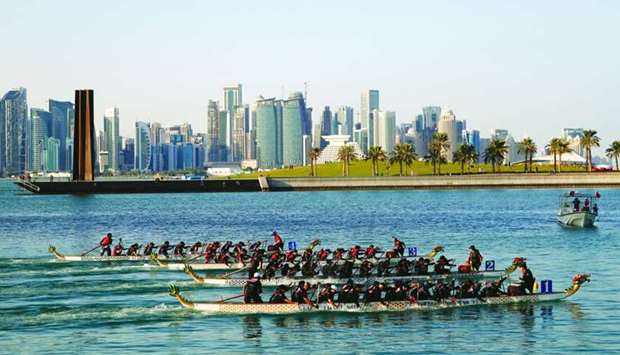Establishing a circular economy (CE) action plan with concrete policies and measures is crucial for realising its potentials in Qatar, according to the Invest Qatar Circular Economy Policy Paper published by Investment Promotion Agency Qatar (IPA Qatar). IPA Qatar stated that the policy paper aims to shed light on circular policies implemented around the globe and derive lessons for Qatar’s development and investment attraction strategies.
“For a long time, a linear model of production and consumption has dominated the world economy.
Raw materials are extracted to make products that are then thrown away at the end of their lifecycle…the circular economy offers an alternative path that can yield enormous economic, social, and environmental benefits,” the paper emphasised.
While CE is gaining attention worldwide as a means for societies to increase prosperity while preserving the natural environment, the paper pointed out that Gulf Co-operation Council (GCC) countries have seen accelerated development in all aspects of life on the back of solid government finances accumulated through hydrocarbon revenues.
The paper stressed that GCC countries are aiming for a transition from hydrocarbon-led economic growth to sustainable models.“CE overcomes the problems of the conventional linear model and could provide new opportunities for the GCC countries to tackle the challenges they face,” the paper stated.
With CE and waste management being one of the four key pillars of Qatar’s national environment and climate strategy, the government has explored sustainability solutions in multiple sectors and factored CE thinking into its strategic outlook, the paper stressed.
“This pillar stipulates that Qatar aims to enhance critical infrastructure for sustainable waste management and drive more circular use of materials by closing and rehabilitating 100% of unsanitary landfills and achieve a 15% material recycling rate of municipal waste, among other targets.
“Despite these ambitious circular targets, Qatar is yet to adopt an all-encompassing, nationwide CE strategy, with a clear priority setting of sectors and measures covering the whole lifecycle of products.
The linear model is coming to an end and Qatar can bolster its economy, improve competitiveness, preserve the environment and build a sustainable economy by moving towards circularity,” the paper further stated.
According to IPA Qatar, establishing a CE action plan with concrete policies and measures covering the whole life cycle of products – from manufacturing and consumption to waste management and the market for recyclables – is crucial for realising its potentials.
To accelerate the shift, the paper noted that employing circular practices in priority sectors, such as transportation and energy, “is critical.” Similarly, other key factors to scale CE practices include raising awareness, establishing partnerships, cooperating with platforms, calling for more research and development on the subject, and direct governmental support for circular business models.
“A CE is set to bring enormous financial, social, and environmental benefits to Qatar, the region, and the world if implemented correctly.
With a circular model, Qatar is set to generate an additional $17bn by 2030, corresponding to 10% of its GDP, create an estimated 9,000 to 19 000 jobs by 2030, increase disposable income, attract more greenfield FDI as the world gravitates towards sustainable investing, and most importantly, achieve a balance between economic growth and environmental stewardship,” the paper added.
“For a long time, a linear model of production and consumption has dominated the world economy.
Raw materials are extracted to make products that are then thrown away at the end of their lifecycle…the circular economy offers an alternative path that can yield enormous economic, social, and environmental benefits,” the paper emphasised.
While CE is gaining attention worldwide as a means for societies to increase prosperity while preserving the natural environment, the paper pointed out that Gulf Co-operation Council (GCC) countries have seen accelerated development in all aspects of life on the back of solid government finances accumulated through hydrocarbon revenues.
The paper stressed that GCC countries are aiming for a transition from hydrocarbon-led economic growth to sustainable models.“CE overcomes the problems of the conventional linear model and could provide new opportunities for the GCC countries to tackle the challenges they face,” the paper stated.
With CE and waste management being one of the four key pillars of Qatar’s national environment and climate strategy, the government has explored sustainability solutions in multiple sectors and factored CE thinking into its strategic outlook, the paper stressed.
“This pillar stipulates that Qatar aims to enhance critical infrastructure for sustainable waste management and drive more circular use of materials by closing and rehabilitating 100% of unsanitary landfills and achieve a 15% material recycling rate of municipal waste, among other targets.
“Despite these ambitious circular targets, Qatar is yet to adopt an all-encompassing, nationwide CE strategy, with a clear priority setting of sectors and measures covering the whole lifecycle of products.
The linear model is coming to an end and Qatar can bolster its economy, improve competitiveness, preserve the environment and build a sustainable economy by moving towards circularity,” the paper further stated.
According to IPA Qatar, establishing a CE action plan with concrete policies and measures covering the whole life cycle of products – from manufacturing and consumption to waste management and the market for recyclables – is crucial for realising its potentials.
To accelerate the shift, the paper noted that employing circular practices in priority sectors, such as transportation and energy, “is critical.” Similarly, other key factors to scale CE practices include raising awareness, establishing partnerships, cooperating with platforms, calling for more research and development on the subject, and direct governmental support for circular business models.
“A CE is set to bring enormous financial, social, and environmental benefits to Qatar, the region, and the world if implemented correctly.
With a circular model, Qatar is set to generate an additional $17bn by 2030, corresponding to 10% of its GDP, create an estimated 9,000 to 19 000 jobs by 2030, increase disposable income, attract more greenfield FDI as the world gravitates towards sustainable investing, and most importantly, achieve a balance between economic growth and environmental stewardship,” the paper added.




